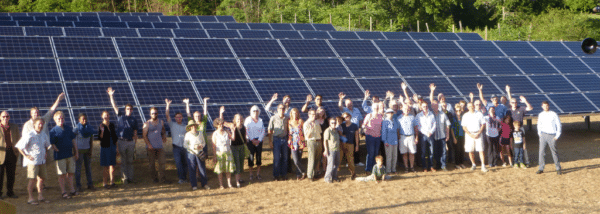In California, there has been a multi-year war waged over the fate of a mechanism called net energy metering (NEM). The process involves customers sending their excess solar-generated electricity to the grid and receiving a credit on their utility bill at a retail rate for all exported electricity.
A new revised NEM proposal is set to be released on November 8, 2022. It will be watched closely by Californians as utilities now argue that the enactment of the Inflation Reduction Act will make fair net metering rates unnecessary.
Net Energy Metering has been a critical policy in launching the California rooftop solar market, which has grown to a robust 1.3 million homes covered in panels, representing about 50% of the US residential market. It also helped launch distributed commercial rooftop projects, another key part of California’s race to electrical decarbonization.
It came under threat when a new investor-owned utility-backed proposal, NEM 3.0, was placed on the California Public Utilities Commission (CPUC) desk. The proposed decision included roughly an 80% reduction in the payment for excess solar energy sent to the grid, and tacks on an $8 per kW monthly charge for all solar customers, regardless of whether they have battery energy storage or not. A common-sized 8 kW system would be charged $64 a month, a fee that makes solar a non-option for most customers.
In fact, at the time of the proposal, a survey of 4,000 active home solar shoppers found that 95% of homeowners were no longer interested in buying solar after viewing the cost assumptions of the new rate plan. Laura Deehan, state director Environment California condemned the proposal as “a tax on the sun.”
(Read: “Thousands of Californians protest NEM 3.0”)
After the proposal was decried by environmentalists, energy experts, jobs experts and Californian citizens alike, it was revised. The new decision was still chock-full of anti-rooftop solar and pro-centralized utility structuring.
“Non-bypassable charges” that were added in the revised NEM 3.0. These charges would add a proposed $0.05/kWh to all customers, whether they have solar on their roof or not. The charges would even apply to power generated by the customer’s home solar system, which is unconventional considering the utility does not have ownership over the solar array and did not invest in it. For context, the average American pays about $0.145/kWh for electricity, so the addition of a $0.05/kWh non-bypassable charge would be a heavy hitter on Californians’ utility bills.
ROTH Capital Partners Phil Shen said in an industry note that the new proposal, expected on November 8, may add a $10 to $20 per month fixed charge and a rapid glide path to low export rates between two to six cents per kWh. This net metering payment is a far cry below the 29 cents per kWh the average Californian is charged by the utility.
Cost shift?
The reason behind the policy appears simple, investor-owned utilities want to sell Californians power, they want to retain monopoly control. NEM 3.0 is backed by all the major utilities in the state, including PG&E, SCE, and SDG&E.
The utilities have pushed the concept of a “cost shift,” indicating that rich Californians reap the benefits of rooftop solar while poorer Californians pick up the tab for net metering costs. However, this theory has held little water under analysis, and new policy and data makes the argument even more flimsy.
Sixteen state-level studies have disproven the cost-shift argument, as has a national study, completed by Lawrence Berkeley National Lab (LNBL). Berkeley found that 40 of the 43 states and Washington D.C. with net metering programs have a negligible cost increase attributed to solar, and in many cases had cost benefits. Read more about the utility-backed push of NEM 3.0 and the cost shift argument here.
Two major changes
The cost shift argument holds even less weight under the light of new data from LNBL and new policy in the state.
In its annual Residential Solar-Adopter Income and Demographics Trends report, it found that about one-third of California households that installed rooftop solar in 2021 were solidly working- and middle-class families, with annual incomes between $50,000 and $100,000. Only 12 percent of households had annual incomes of $250,000 or more. It also found that the median income among all U.S. households that installed solar in 2021 was roughly $110,000, compared to $129,000 in 2010.
“The numbers of middle-income California households adopting rooftop solar is encouraging news and further underscores how successful the state’s current financial incentives have been at making the clean energy option available for budget-minded families,” said EWG President and California resident Ken Cook.
These findings buck the argument that working-class families are subsidizing richer residents. But what about renters, and those with homes unsuitable for rooftop solar? New policy changes have also made headway in this area.
Following Governor Gavin Newsom’s signature, California passed AB 2316, the Community Renewable Energy Act. The law creates a community renewable energy program, including community solar-plus-storage, to overcome access barriers for nearly half of Californians who rent or have low incomes.

Community solar projects are often smaller than utility-scale facilities, and are ideally built on landfills, former industrial sites, and other brownfield locations. Customers typically subscribe to a share of energy produced by the local clean energy project, accessing lower bills and reducing their carbon footprint.
Without the ability to purchase and install solar directly on a rented residence, community solar offers a pathway to the 45% of Californians who rent their homes, and the 70% of renters who are considered low-income. The program’s structure ensures that at least 51% of subscribers are low-income customers, triggering at least a 40% federal tax credit on solar panels under the Inflation Reduction Act.
“Community renewable energy is a proven powerful tool to help close California’s clean energy gap, bringing much needed relief to millions struggling with high housing costs and utility debt,” said Alexis Sutterman, energy equity program manager at the California Environmental Justice Alliance.
The new NEM proposed decision will be presented to the CPUC on November 8. Utilities now argue that fair net metering rates aren’t necessary based on new clean energy incentives created by the Inflation Reduction Act of 2022. But those who understand the value of distributed rooftop solar aren’t buying it.
“The CPUC and Gov. Newsom should follow the facts, not the narrow interests of the power companies, and reject their plot to rip away access to rooftop solar for working-class Californians. The data shows these are the folks relying the most on the state’s residential solar program,” said Cook.
Those interested in supporting a healthy, long-term extension of fair rooftop solar rulemaking can sign a petition created by the Environmental Working Group of California.



